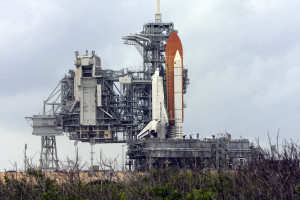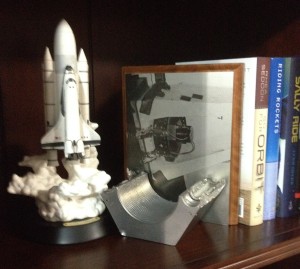What’s the Hold Up?
Nuts and Bolts…
Most people think that the Space Shuttle vehicle itself sat on the launch pad ready for launch. It didn’t. Only the nozzles of the Solid Rocket Boosters were attached to the launch platform. Like a giant fat bird, balanced on two tiny feet, the boosters were holding up the entire thing.
Here’s the tale of how they were held securely in place – and let go for launch.
There were over a million moving parts on the Shuttle: more than any other human invention! Many of these bits and pieces had to work in harmony—perfectly—to raise the vehicle from the Earth and into orbit. Many had redundancy, a backup. In fact, many pieces of equipment or systems were “fail safe” devices. That is aviation lingo meaning if the primary system fails, a second system would take over, and if that backup system failed, there was another way to get safely home.
We all understood that there were a few things that simply had to work because there was no back up. The boosters had to lift us free from Earth simultaneously. There were things that could keep that from happening.
Each of the two boosters was held in place by four, hold-down bolts. A very large bolt came up from below the launch pad and screwed through a very heavy nut and into a post on the booster nozzle. These eight screws were all that were holding four and a half million pounds of vehicle upright. And there they sat awaiting the moment of launch.
Through the whistling winds, they held.
Through raging thunderstorms, they held.
Through the loading of massive satellites destined for space, they held.
And through the jostling of equipment and people working onboard, they held.
More remarkably, when the Shuttle’s main engines fired up seconds before launch, creating a million pounds of thrust upward and blasting the nearby area with tremendous flame and heat, they held. Since the engines were tilted, they made the entire stack sway backward a foot or two. Straining mightily, the bolts held.
Six seconds later, at the millisecond the boosters were commanded to fire, the nuts that held the massive screws in place were commanded to cleave in two. The commands to the explosives for this rending always had to go to each of the eight nuts—flawlessly and simultaneously—in order for the screws to drop away, allowing our space ship to launch upward…free from the planet’s gravity.
Most of the physical objects associated with our flights were discarded or put into NASA’s archives. Precious few items became the crew’s own property. Oddly enough, instead of throwing away the heavy metal, split in two, nuts they were given back to us. The thoughtful people at the Kennedy Space Center were kind enough to keep them, clean them up, and make them into bookends for crew members and other important contributors to the mission.
They are the heaviest bookends I have and not the fanciest, but they are my favorite. In their own way, they are most beautiful. They fulfilled their destiny: torn apart, seared by the incredible heat of main engines and boosters firing down upon them. Their destiny made mine possible.
– Rhea
We’d love to add you to our email list. If you have not yet signed up, please do so by clicking here.





I was aware of the nuts and that they were made into bookends; but I had never seen the finished product. Thanks for a great story and further clarification on how the shuttle launched.
From which of your flights? And were you given them as-is, or with a plaque denoting what flight?
wow!!!!! Great read!!!!